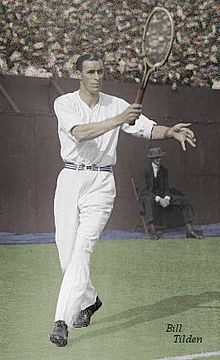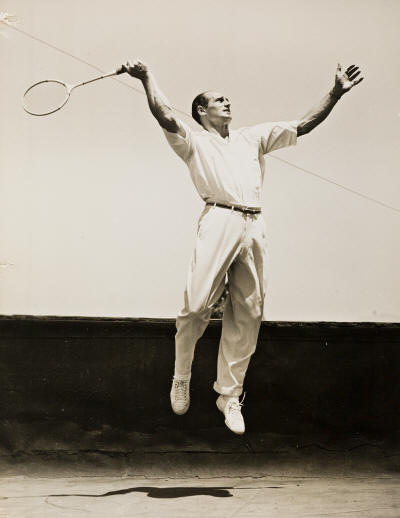
Queer Places:
University of Pennsylvania (Ivy League), 3355 Woodland Walk, Philadelphia, PA 19104
2025 Argyle Ave, Los Angeles, CA 90068, USA
Ivy Hill Cemetery Philadelphia, Philadelphia County, Pennsylvania, USA, Plot Section D
 William Tatem Tilden II[1] (February 10, 1893 – June 5, 1953), nicknamed "Big Bill," was an American male tennis player. He is often considered one of the greatest tennis players of all time.[2] Tilden was the World No. 1 player for six years from 1920 through 1925. He won 15 Major singles titles including ten Grand Slam events, one World Hard Court Championships and four Pro Slam tournaments. He was the first American to win Wimbledon in 1920. He also won a record seven U.S. Championships titles (shared with Richard Sears and Bill Larned).
William Tatem Tilden II[1] (February 10, 1893 – June 5, 1953), nicknamed "Big Bill," was an American male tennis player. He is often considered one of the greatest tennis players of all time.[2] Tilden was the World No. 1 player for six years from 1920 through 1925. He won 15 Major singles titles including ten Grand Slam events, one World Hard Court Championships and four Pro Slam tournaments. He was the first American to win Wimbledon in 1920. He also won a record seven U.S. Championships titles (shared with Richard Sears and Bill Larned).
Tilden dominated the world of international tennis in the first half of the 1920s, and during his 18-year amateur period of 1912–29, won 138 of 192 tournaments. He owns a number of all-time tennis achievements including a career match winning record and a career winning percentage at the U.S. National Championships. At the 1929 U.S. National Championships Tilden became the first player to reach 10 finals at a single Grand Slam event. His ten finals at a grand slam tournament remained a record until 2017, when Roger Federer reached his eleventh Wimbledon final. Tilden, who was frequently at odds with the rigid United States Lawn Tennis Association about his amateur status and income derived from newspaper articles, won his last Major title in 1930 at Wimbledon aged 37. He turned professional on the last day of that year and toured with a handful of other professionals for the next 15 years.
Bill Tilden was born on February 10, 1893, in Germantown, Philadelphia, into a wealthy family bereaved by the death of three older siblings. His father was William Tatem Tilden, a wool merchant and local politician; and his mother, Selina Hey, was a pianist.[3] He lost his semi-invalid mother, who suffered from Bright's disease, when he was 18; and, even though his father was still alive and maintained a large house staffed with servants, Bill was sent a few houses away to live with a maiden aunt. The loss at 22 of his father and an older brother Herbert marked him deeply. After several months of deep depression and, with encouragement from his aunt, tennis, which he had taken up at age six or seven at the family summer house in the Catskill Mountains, became his primary means of recovery. According to his biographer, Frank Deford, because of his early family losses, Tilden spent all of his adult life attempting to create a father-son relationship with a long succession of ball boys and youthful tennis protégés, of whom Vinnie Richards was the most noted. In spite of his worldwide travels, Tilden lived at his aunt's house until 1941, when he was 48 years old.

JACK PASHKOVSKY (1911-2001)
A pair of photographs depicting tennis star Bill Tilden.
Silver prints, the images measuring 229x178 mm; 9x7 inches, the sheets slightly larger, each with Pashkovsky's credit stamp on verso. Circa 1935.
Bill Tilden was the first American to win the Wimbledon men's singles title in 1920, and for the following 6 years, he won every major tournament he entered. In the 1940s, Tilden's life was riddled with scandal as his sexuality, which had been somewhat known among his inner circles, but not publicized, came to light after two arrests for soliciting sex from teenage boys. Despite pervasive prejudice against gay men in the forties and fifties, and the public shock at his arrests and convictions, it is a testament to Tilden's talents that he was still considered synonymous with tennis in 1950. Over time, however, he was largely erased from tennis history and forgotten and shunned by both his tennis and Hollywood circles.
Tilden was initially home-schooled; but in 1908, he went to Germantown Academy. He later attended the University of Pennsylvania, where he was a reluctant student, and graduated from Peirce College.
Tilden went to the prep school Germantown Academy where he wasn't known for his tennis nor was he eventually good enough to play on his college team. The shy, self-absorbed, sometimes arrogant young man dropped out of the University of Pennsylvania and in 1910 began to practice his game against a backboard, and he also became a dedicated student of the game.[4] The following year he won his first tournaments; the junior singles and doubles title of Germantown.[5] He later enrolled at the Peirce School of Business.[6] In just three years, he worked his way up the ranks. His first national title was winning the mixed doubles championships with Mary Browne in 1913 and they successfully defended the title in 1914.
From 1914 to 1917, Tilden won the Philadelphia championship. Prior to 1920, he had won a number of Canadian doubles titlesCitation needed|date=September 2009, but at the U.S. National Championships in 1918 and 1919 he lost the singles final to Robert Lindley Murray and "Little Bill" Johnston, respectively in straight sets. He won six consecutive U.S. singles championships from 1920–1925 and seven in total, making him the co-record holder with Richard Sears and Bill Larned.[7] [8] In the winter of 1919–20, he moved to Rhode Island where, on an indoor court, he devoted himself to remodeling his relatively ineffective backhand into a much more effective one. With this change, he became the world no. 1 tennis player and the first male American to win the Wimbledon singles championship. In the mid 1920s Tilden came into conflict with the USLTA regarding alleged violations of the amateur rule, specifically relating to the monetary compensation he received for writing tennis articles.[9]
In the late 1920s, the great French players known as the "Four Musketeers" finally wrested the Davis Cup away from Tilden and the United States, as well as his domination of the singles titles at Wimbledon and Forest Hills. Tilden had long been at odds with the rigid amateur directors of the United States Lawn Tennis Association about his income derived from newspaper articles about tennis.[10] He won his last major championship at Wimbledon in 1930 at the age of 37, but was no longer able to win titles at will.
On 31 December 1930, in need of money, he turned professional and joined the fledgling pro tour, which had begun only in 1927. For the next 15 years, he and a handful of other professionals such as Hans Nüsslein and Karel Koželuh barnstormed across the United States and Europe in a series of one-night stands, with Tilden still the player that people primarily paid to see. Even with greats such as Ellsworth Vines, Fred Perry, and Don Budge as his opponents, all of them current or recent world no. 1 players, it was often Tilden who ensured the box-office receipts—and who could still hold his own against the much younger players for a first set or even an occasional match.
Tilden thought he reached the apogee of his whole career in 1934 at 41 years old; nevertheless, that year he was dominated in the pro ranks by Ellsworth Vines. ''American Lawn Tennis'' reported that Vines had an edge of 11–9 in the first phase of their tour from January 10 through February 16 and that Vines led Tilden by 19 matches after the second phase of their tour, played from March 21 through May 17. Tilden had won 17 times for the entire year, per an Associated Press report,[11] so a probable win-loss record at tour's end was 36–17 in Vines' favor. Both players then met at least 6 times during the rest of the year (Ray Bowers has listed 5 tournament matches and 1 one-night program), all lost by Tilden.
In 1945, the 52-year-old Tilden and his long-time doubles partner Vinnie Richards won the professional doubles championship—they had won the United States amateur title 27 years earlier in 1918.
Tilden coached Germany's tennis team in the 1937 Davis Cup. In the inter-zone finals, the U.S. team won after the deciding singles clash between Gottfried von Cramm and Don Budge, a match which has been called "The Greatest Tennis Match Ever Played".[12]
Allison Danzig, the main tennis writer for ''The New York Times'' from 1923 through 1968, and the editor of ''The Fireside Book of Tennis'', called Tilden the greatest tennis player he had ever seen. "He could run like a deer," Danzig once told CBS Sports. An extended Danzig encomium to Tilden's tennis appears in the July 11, 1946 issue of ''The Times'', in which he reports on a 1920s-evoking performance in the first two sets of a five-set loss by the 53-year-old Tilden to Wayne Sabin, at the 1946 Professional Championship at Forest Hills.[13]
In his 1979 autobiography, Jack Kramer, the long-time tennis promoter and great player himself, included Tilden in his list of the six greatest players of all time.[14] Kramer began playing tennis with Tilden at age 15 at the Los Angeles Tennis Club (LATC).
Tilden, who was one of the most famous athletes in the world for many years, today is not widely remembered, despite his former renown. During his lifetime, however, he was a flamboyant character who was never out of the public eye, acting in both movies and plays, as well as playing tennis. He also had two arrests for sexual misconduct with teenage boys in the late 1940s; these led to incarcerations in the Los Angeles area. After his convictions he was shunned in public. Philadelphia's Germantown Cricket Club, his home court, revoked his membership and took down his portrait.[15] Tilden's criminal record has cast a long shadow: In March 2016 a proposal to honor him with a historical marker at the club was voted down by the state of Pennsylvania panel charged with evaluating nominations.[16] In 1950, in spite of his legal record and public disgrace, an Associated Press poll named Tilden the greatest tennis player of the half-century by a wider margin than that given to any athlete in any other sport (310 out of 391 votes).[17] He was inducted into the International Tennis Hall of Fame in 1959.
In the United States' sports-mad decade of the Roaring Twenties, Tilden was one of the six dominant figures of the "Golden Age of Sport", along with Babe Ruth, Howie Morenz, Red Grange, Bobby Jones, and Jack Dempsey.[18]
Tilden was arrested in November 1946 on Sunset Boulevard by the Beverly Hills police and charged with a misdemeanor ("contributing to the delinquency of a minor") for soliciting an underage male, a 14-year-old boy with whom he was having sex in a moving vehicle. Tilden did not carry his glasses with him and signed a confession without reading it.[19] He was sentenced to a year in prison, but served 7½ months. His five-year parole conditions were so strict they virtually erased all his income from private lessons. He was arrested again in January 1949, after picking up a 16-year-old hitchhiker who remained anonymous until years later, when he filed a lawsuit claiming he had suffered severe mental, physical, and emotional damage from the encounter. The judge sentenced Tilden to a year on probation violation and let the punishment for the charge run concurrently. Tilden served ten months. In both cases, apparently, he sincerely believed that his celebrity and his longtime friendship with Hollywood names such as Charlie Chaplin were enough to keep him from jail. He therefore defended himself in court in both cases in a far less than vigorous fashion. After his incarceration, he was increasingly shunned by the tennis and Hollywood world. He was unable to give lessons at most clubs, and even on public courts he had fewer clients. At one point, he was invited to play at a prestigious professional tournament being held at the Beverly Wilshire Hotel; at the last moment, he was told that he could not participate.[20] Chaplin allowed Tilden to use his private court for lessons to help him after the run of legal and financial problems.[21]
According to contemporary George Lott, a player and later tennis coach at DePaul University, and authoritative biographer Frank Deford, Tilden never made advances to players, whether other adults or his pupils. Art Anderson of Burbank, who took lessons from Tilden from the age of eleven and remained a lifelong loyal friend, reported that Tilden never made advances toward him.[22] “Bill had all the rumors floating around about his sexuality,” Jack Kramer said.[23] Questions remain if Tilden's prosecution was based on the rumors, many published, and homophobic stereotypes. California did not repeal its sodomy law until 1976. Because he lived in an era when homosexual sex was illegal and was not tolerated socially, some suspect that Tilden was a victim of the homophobic society of the era.[24] More shocking than Tilden's being caught was the revelation that "sports and homosexuality were not mutually exclusive".[25]
Although Tilden had been born to wealth, and earned large sums of money during his long career, particularly in his early years on the pro tour, he spent it lavishly, keeping a suite at the Algonquin Hotel in New York City. Much of his income went towards financing Broadway shows that he wrote, produced, and starred in.[26] The last part of his life was spent quietly and away from his family, occasionally participating in celebrity tennis matches. He died in his apartment at 2025 North Argyle in Los Angeles, California. He was preparing to leave for the United States Professional Championship tournament in Cleveland, Ohio, in 1953 when he died from heart complications at age 60. Tilden is buried in Ivy Hill Cemetery in Philadelphia.[27]
Tilden was inducted into the International Tennis Hall of Fame in Newport, Rhode Island, in 1959.
My published books:


BACK TO HOME PAGE

- ^ Bill Tilden, From Wikipedia, the free encyclopedia


 William Tatem Tilden II[1] (February 10, 1893 – June 5, 1953), nicknamed "Big Bill," was an American male tennis player. He is often considered one of the greatest tennis players of all time.[2] Tilden was the World No. 1 player for six years from 1920 through 1925. He won 15 Major singles titles including ten Grand Slam events, one World Hard Court Championships and four Pro Slam tournaments. He was the first American to win Wimbledon in 1920. He also won a record seven U.S. Championships titles (shared with Richard Sears and Bill Larned).
William Tatem Tilden II[1] (February 10, 1893 – June 5, 1953), nicknamed "Big Bill," was an American male tennis player. He is often considered one of the greatest tennis players of all time.[2] Tilden was the World No. 1 player for six years from 1920 through 1925. He won 15 Major singles titles including ten Grand Slam events, one World Hard Court Championships and four Pro Slam tournaments. He was the first American to win Wimbledon in 1920. He also won a record seven U.S. Championships titles (shared with Richard Sears and Bill Larned).